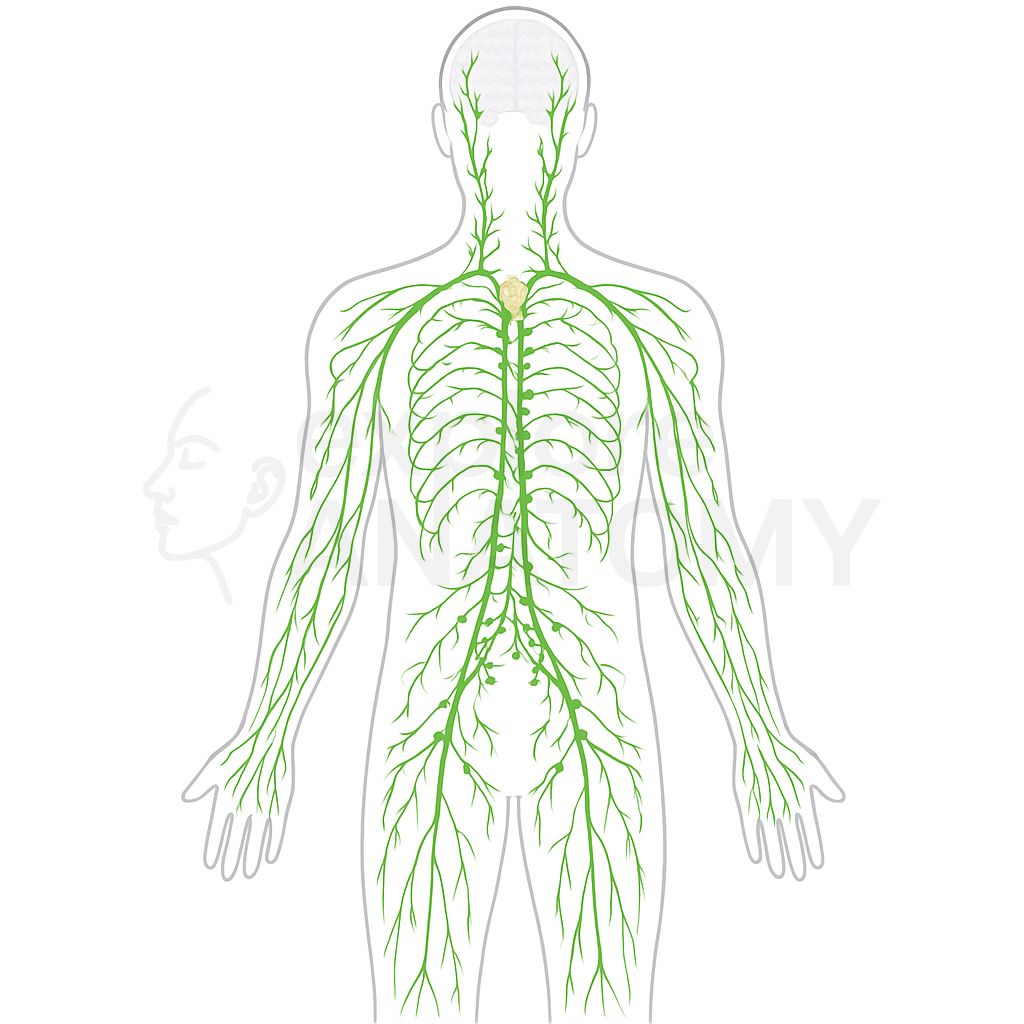Lymphatic System
The lymphatic system is a network of vessels, nodes, and organs that helps maintain fluid balance, absorbs dietary fats, and supports immune defense. It transports lymph—a clear fluid containing white blood cells—throughout the body and plays a key role in identifying and responding to pathogens.

Search Lymphatic System
Discover the various components and structures that make up the Lymphatic System.
Lymphatic System Components
Anterior Mediastinal Nodes
Drain anterior thoracic structures.
Apical Axillary Nodes
Located at the apex of the axilla.
Appendix
Lymphoid-rich structure of the large intestine.
Axillary Lymph Nodes
Drain the upper limbs and chest wall.
BALT
Bronchus-associated lymphoid tissue.
Bronchomediastinal Trunk
Drains lymph from thoracic organs.
Central Axillary Nodes
Located centrally in the armpit.
Cisterna Chyli
Dilated sac at the start of the thoracic duct.
Deep Cervical Lymph Nodes
Located along internal jugular vein; receive lymph from head and neck.
GALT
Gut-associated lymphoid tissue.
Iliac Lymph Nodes
Include external, internal, and common iliac nodes.
Inguinal Lymph Nodes
Drain the lower limbs and external genitalia.
Intestinal Trunk
Drains lymph from the intestines.
Jugular Trunk
Drains lymph from the head and neck.
Lateral Axillary Nodes
Located along the humerus in the axilla.
Lingual Tonsils
Located at the base of the tongue.
Lumbar Trunk
Drains lower limbs and pelvic organs.
Lymphatic Capillaries
Initial lymphatic vessels that collect interstitial fluid.
Lymphatic Collecting Vessels
Carry lymph through lymph nodes.
Lymph Nodes
Small structures that filter lymph and store immune cells.
MALT
Mucosa-associated lymphoid tissue.
Mastoid Lymph Nodes
Drain the posterior scalp and ear.
Mesenteric Lymph Nodes
Drain the intestines and abdominal structures.
NALT
Nasal-associated lymphoid tissue.
Occipital Lymph Nodes
Drain the back of the scalp.
Palatine Tonsils
Located on each side of the oropharynx.
Para-aortic Lymph Nodes
Drain abdominal viscera and lower limbs.
Paratracheal Nodes
Located lateral to the trachea.
Parotid Lymph Nodes
Drain the lateral face and scalp.
Pectoral Axillary Nodes
Located along the anterior chest wall.
Peyer’s Patches
Lymphoid nodules in the small intestine.
Pharyngeal Tonsil
Located in the nasopharynx (adenoids).
Popliteal Lymph Nodes
Drain the foot and leg.
Posterior Mediastinal Nodes
Drain posterior thoracic structures.
Preaortic Nodes
Located in front of the aorta.
Pretracheal Nodes
Located anterior to the trachea.
Red Bone Marrow
Produces lymphocytes; site of B-cell maturation.
Retroaortic Nodes
Located behind the aorta.
Right Lymphatic Duct
Drains right upper quadrant of the body.
Sacral Lymph Nodes
Drain the pelvic floor and rectum.
SALT
Skin-associated lymphoid tissue.
Spleen
Filters blood and initiates immune response.
Subclavian Trunk
Drains lymph from the upper limbs.
Submandibular Lymph Nodes
Drain the face, mouth, and pharynx.
Submental Lymph Nodes
Drain the floor of the mouth and central lower lip.
Subscapular Axillary Nodes
Located along the posterior chest wall.
Superficial Cervical Lymph Nodes
Drain superficial structures of the head and neck.
Supraclavicular Lymph Nodes
Located above the clavicle; key in thoracic drainage.
Thoracic Duct
Main lymphatic duct draining most of the body.
Thymus
Primary lymphoid organ for T-cell maturation.
Tracheobronchial Nodes
Drain lungs and bronchi.
Tubal Tonsils
Near openings of the auditory tubes.
Waldeyer’s Ring
Ring of lymphoid tissue surrounding the naso- and oropharynx.